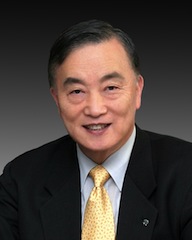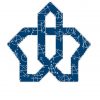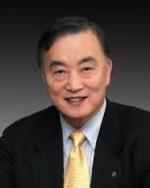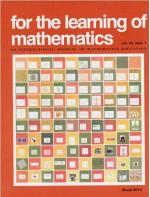
MENAO20140812eng, the Korean story at MENAO, English version
Mathematics, a fundamental pillar of Korean economic development.
By KunMo Chung, former Minister of Science and Technology
Opening
The first phase. 1950-1960’s: Math as a standard of scholastic excellence
Opening
1-1 Pursuit of a better living standard
1-2 Insufficient educational infrastructure
1-3 Math, measure of one’s educational success
Closing
The second phase. 1970-1980’s: Math as a pillar of economic development
Opening
2-1. Return of students sent abroad
2-2. Increase in the number of engineering majors
2-3. Math education boom
Closing
The third phase. 1990-2000’s: Math as a source of advanced economy
Opening
3-1. Invigoration of mathematical sciences
3-2. Qualitative leap of math
3-3. Dramatic improvement of prestige of Korean math
Closing
Looking Forward
Opening
I appreciate the kind introduction. Dear mathematicians from emerging nations, distinguished speakers and honored guests, I sincerely appreciate what you have done as scholars and your visit to Korea, our beloved nation. I warmly welcome all of you. As many of you have heard of, Korea had been occupied by Japan for 36 years early last century and became an independent state after the Second World War by the resolution of the United Nations.However, the Korean War broke out shortly after our independence and left the entire Korea destroyed by the War. Statistically, in terms of GDP per capita, Korea was one of the poorest nations in the world in 1950’s. After 60 years from then, South Korea has transformed into a completely new nation. If you had visited Korea half century ago, you should have noticed the remarkable transformation of our country during the past six decades. In 2012, Korea became the 7th member of 20-50 club which is an unofficial list of countries of GDP per capita over $20,000 and the population over 50 millions. Consequently the Republic of Korea became the 10th largest economy in the world. At the same time, Korea had rapidly achieved democratization politically and led a cultural upstart called “Han-ryu” which means Korean culture wave. Korea is emerging as a culture export nation from a culture import nation. Our singer/rapper Mr. Psy’s “Gangnam style” had over 2 billion viewers and wrote a new history in YouTube. This very place where we are hosting this year’s ICM is the Gangnam of Gangnam Style. Such Korean economic development, political transformation and cultural revolution were only made possible by the visions of our national leaders, bold challenges of our corporations, our emerging academia and perspiration of Korean people. However there is an unknown story behind our nation’s success. It is, as the title of this presentation goes, mathematics that had been a fundamental pillar of Korean nation-building through education, science and technology. I am an engineer and scientist but I believe that engineering, science and economics and many other fields have mathematics as their fundamental bases. As I prepared this presentation, I found a unique theme provided the basis of our nation-building during the past sixty years. That theme was our faith in Education, Science and Technology. The pillar of this faith has been the role and value-generation of mathematics et me now share our experience with you.
The first phase. 1950-1960’s: Math as a standard of scholastic excellence.
Opening
Until 1950’s, Korea was a typical agricultural country. Since the Korean War swept the country and devastated its land, GNP per capita of the country was only $76. What was the Korea’s response to overcome this seemingly bleak challenge “Let’s make Korea a modern nation!”.
1-1 Pursuit of a better living standard
Most Koreans who experienced poverty for long had been put into more severe conditions due to the tragic Korean War. On the other hand, awakened from suffering, Koreans ignited their hearts with the idea of “Let’s pursue a better living standard.” The desperate slogan “Let’s pursue a better living standard” motivated the entire South Korea population.Initially through “diligence.”
There is a research on the number of strides per minute in that time. Americans walked 25 strides, British walked 29 strides and Japanese walked 35 strides while Koreans walked 56 strides. The mere word “walk” is not adequate to describe Koreans’ life styles. The life styles were rather close to “running.” This exemplifies how hard Koreans worked. “Diligence” is still our number one virtue. “빨리빨리” is a phrase refered to Koreans.
1-2 Insufficient educational infrastructures
In order to bounce back from the rock bottom, proper education was desperately needed but Korea was in severe lack of school infrastructures, trained teachers and textbooks. Then the Minister of Education, Doctor NakJun Baek, sought for aid while he was visiting America. He invested all $100,000 which he managed to raise from UNESCO into printing facilities to produce textbooks. From the harsh studying environments, some students had to study under tents for years. I myself spent my middle and high school years in tent class rooms. However, we studied mathematics to prove our scholastic aptitude and excellence. There were many mathematical contests. And academic advancement, mathematical skills and capabilities were the measure of recognition. The circumstance was not better in colleges and universities. It was hard to find qualified professors and there were no laboratories. The only way to obtain a graduate degree was to study abroad and only a very few people could afford studying abroad. Because of the lack of foreign-exchange reserves in Korea, each student could leave the country with only $100. Being financially challenged, Korean students had to fight in two facets :
they had to study during day and they had to struggle to support themselves by working at night. Until 1960, there were less than 60 people who had received their doctoral degrees from foreign institutes.\
1-3 Math, measure of one’s educational success.
Hendrick Hamel introduced Korea to Europe through his book “The Journey of Hendrick Hamel” in late 17th century. In this book, he wrote “Korean children are always reading books day and night. It is such a wonder that the children understand books remarkably well.” Another story came from the book “Le tour du monde” written by a French naval officer Jean Henri Zuber in late 19th century. In this book, he said “It is admirable that books are present in every single household including poor ones. This also hurts our pride.” It was Korea’s tradition of stressing scholarship and this enabled Korea to flourish rapidly from a devastated nation. In 1960’s, there were increasing number of people who sold their lands and cows which were major resource of farming in order to pay tuitions of their children for higher education. These people devoted their whole lives on education to make their children have better life than their own. There was nothing stronger than the conviction of making their children successful through education. Again, mathematics has been at the center of education. From elementary school, Koreans are trained to develop mental arithmetic skills and abacus calculation. This provided basic knowledge of math to the many Koreans. Even before the launch of International Mathematical Olympiad, Korea had national math competitions for elementary and middle school students in 1950’s. In the 3rd grade one of exam problems in math, I recall, was to prove Pythagoras’s theorem. This gives a good idea of the level of math education in Korea back then. In middle schools most honor students joined the math clubs. It was imperative to have good math scores in order to enter prestigious schools. Math differentiated the students and hence students had spent more time on math.
Closing
The vision of making Korea a modern nation and the importance of education were closely linked. Education and training math skills was recognized as the nucleus of academic excellence and scholastic aptitude.
The second phase. 1970-1980’s: Math as a pillar of economic development
Opening
From 1970’s, manufacturing companies of automobiles, shipbuilding, steels and electronics began to emerge. Oil shock accelerated Korean companies to expand overseas during construction boom. From 1980’s, the Korean government pushed Korean industrialization. Particularly, Korean policy makers saw the need of highly trained human resources in order to push export-oriented industrialization. They also recognized the importance of
R&D work and indeginous capability, which calls for a higer level of mathematics.
2-1. Return of students sent abroad
Luckily, I could play an important role in that era. In the late 1960’s, Dr. John A. Hanna, then the president of Michigan State University became the chief of USAID after Nixon was elected as the president of the United States. Hanna accepted my proposal to build an Advanced Institute for Science and Technology to raise human resources in science and engineering. I had to overcome several difficulties but finally could have built KAIST(Korea Advanced Institute of Science and Technology) in 1971 which was modeled after MIT and was to be an internationally competitive S&T graduate school. According to the survey by the Embassy of the Republic of Korea in the United States, there were 260 Korean professors in America. About half of them were engaged in natural sciences and engineering. I had toured the whole America to recruit faculty members of the new institution for 6 months. I invited 50 professors whose specialties were applied sciences and engineering as the first professors of KAIST. I thought it was necessary to focus on applied fields to achieve economic results in short time. Also companies recruited those who were studying abroad in graduate schools. As the atmosphere was ready for expatriates to contribute to the country, those who had received advanced education abroad came back like salmon run. On the other hand, as the government regulation on studying abroad became relaxed, there was a rush of students who intended to study abroad. This enabled the education for future mathematicians, scientists, engineers and economists who contributed to economic development of Korea after 1990’s. When they came back to Korea, they provided high quality education to next generation of students or developed industry. Through global networking, international research was fostered too. Thus these expatriates provided a fundamental pillar of development of math and IT industry of Korea.
2-2. Increase in the number of engineering majors
Asked of a question “How come Korea produces world’s finest semiconductors while people there do not publish much research papers on the subject?” from a German scientist, Professor SeokGi Min of Kyunghee University answered that “There are numerous young engineers in Korea who have received advanced education and are working in production line and in research.” As satisfying the basic needs was the most urgent issue of the time, engineering was the most popular major because it promises high rate of employment after education. Naturally, increasing number of students went to universities to study science and technology.From the mid 1980’s, the ratio of engineering doctoral degrees has risen significantly. It is observed that the ratio of engineering graduates after 2000’s is very high in Korea compared to those of other countries. As there were more students in engineering, it became easier to find necessary people for each science-technology discipline. Also, among the PhD holders, the ratio of Science-technology PhD holders had increased and this trend became evident mid 1980’s.
2-3. Math education boom
Those who did well in math had entered engineering schools and it was necessary to have good math background to attend good universities. There is an exceptional record that illustrates how much Korean students have focused on math. Since 1950’s the Bible is surely the best seller in Korea. The next is a math book for high school students. This book had been sold more than 40 million copies. Nearly every high school student studied with this book. This shows how much math education was important in Korea. However math education in universities had a different picture from that in high school. In 1970’s almost every university had math department but there were not enough professors who could teach and direct students to do research well because there were not enough PhD holders in Korea. Moreover it was also difficult to buy original textbooks. According to the chair-professor Dong-Pyo Ji of UNIST(Ulsan National Institute of Science and Technology), students had hard time in obtaining original textbooks when he started his professorship in Seoul National University after his study in America. His students copied the books that he brought from America when he came back to Korea. This shows how hard it was to have appropriate materials for advanced math back then in Korea. Consequently, it was hard to keep up with cutting edge development in mathematics abroad and there was merely no interaction with foreign universities, institutes and conferences.
Closing
Developing semiconductor and CD technology during 1980’s and later also IT industry was only possible through the workers and engineers who had actively applied their math skills in the work place. When Korean industry needed cryptographers and digital security experts, Korean mathematicians had nurtured those experts. In other words, math had laid a fundamental pillar of growth of Korea.
The third phase. 1990-2000’s: Math as the source of advanced economy
Opening
People came to realize that even though following developed nation’s technology was successful in economic development for late starters like Korea in the past, it is impossible to go forward without inventing new technology by themselves. From these needs, the Korean government set a new strategy to promote basic sciences. I was fortunate to serve the nation twice as Minister of Science and Technology in 1990s.With the industrial and economic growth, the government and corporations had increased their investment in R&D with increasing industrial research and cooperation between academia and industry, the government could enhance the basic science research. R&D investment of Korea grew to be 4.36% of GDP in 2012 which is a very significant figure compared to those of other countries.
3-1. Invigoration of mathematical sciences
In 1980’s, NRF(National Research Foundation of Korea) promoted funding on SRC (Science Research Centers) under the program of Center of Excellency. Instead of conventional funding of investing on individual researchers, this project invests about a million dollars per year for each research center of more than 20 excellent researchers in a selected basic science field. Korea has funded more than 100 SRC projects. Through this funding, the number of published papers has increased tremendously and so has the number of advanced scientists. Math community has benefited from this project. Starting from Topology and Geometry Research Center at KyungBook national university in 1990, several math SRCs have been established and have advanced math research in Korea: Global Analysis Research Center at Seoul National University in 1991, Algebraic Structure and its Applications Research Center at KAIST in 2007, PDE and Functional Analysis Research Center at SNU in 2009 and Geometry and its Applications Research Center at POSTECH in 2011. These SRCs have advanced math research in Korea tremendously. Established in 1996, KIAS(Korea Institute for Advanced Science) has been taking a leading role in pure mathathematics, theoretical physics and computational sciences. Established in 2005, NIMS(National Institute for Mathematical Sciences) is actively conducting mathematical researches with international activities. Also there have been many establishments of math research institutes in universities, and the increasing government fund for nurturing advanced human resources through Brain Korea 21 project have propelled advancement of mathematical research.
3-2. Qualitative leap of math
According to PISA(Program for International Student Assessment) which measures scholastic aptitude of students in each nation, 31% of Korean students ranked in Level 5 and above in math whereas the average of those of OECD countries was 13% in 2012. Korea belonged to the highest category in this assessment. This reflects enhancement of math education in Korea. In the mean time, Korea has devoted its effort to raise talented students in math and science through establishment of science high schools and education center for talented students in universities. These efforts are observed in the record of Korean IMO results. Participating in IMO for the first time in 1988, Korea was ranked in the 22nd place in the year and it has been ranked in top tier recently. Hosting IMO in 2000, Korea emphasized the importance, developments and roles of mathematics to general public and through these efforts, it raised its national awareness to the subject. Continuing this trend, many talented students are coming to math departments. Recently in top schools, math majors compete medicine majors for the top tier in science-technology fields. Among the 600 entering class of KAIST in 1994, only 2% chose math as their major. This ratio constantly increased to 10% in 2005 and 13% in 2010. Through the high popularity and keen competition, a PhD in math obtained in Korea also has its competitive edge recently compared to those obtained from other internationally prestigious institutions.
3-3. Dramatic improvement of prestige of Korean math
Korea, as a late joining member of IMU, had been in Group 1 for 10 years from 1981 and then it was promoted to Group 2 in 1993. After that it steadily published remarkable results that drew attention from international math community. In 2000’s, there was an epoch-making increase in the number of math papers in Korea and the number of SCIE publication has increased enormously too. Being recognized with these developments, Korea has been promoted from Group 2 to Group 4 at once in 2007. This is unprecedented in the history of IMU. Due to these results, international math community started to view Korean math differently and there are increasing number of non-math professors and specialists in Korea who recognize the importance of math. Even though I am not a mathematician, I am proud of such development of Korean math.
Closing
According to the report “Measuring the economics benefits of mathematical science research in 2010” published by British math society in 2012, approximately 10% of whole Britain’s job is related to math and math contributed 16% of added values in its economy. If we extend this to all jobs in Britain then 45% of added values are related to mathematical research directly or indirectly. On the other hand, the survey on the “best occupation” presented by
CareerCast this April draws our attention. On the basis of working environment, income and amount of stress, mathematician was ranked as 18 the best job. Besides mathematician, statistician was 3rd, actuary was 4th and software engineer was 7th and computer system analyst was 8th. That more than half of the top 10 American occupations were math related ones shows that mathematician is indeed the best job. The current impact of math on society and occupation is incommensurable with that in 20th century. Fundamental basis of science and technology is mathematics. In many processes of making semiconductor, especially in the process of design, math is necessary. The core of automatic control in electrical engineering is math. It was also based on math ability of electrical engineers at ETRI of Korea which first commercialized CDMA which was patented by Qualcomm. The fast development of IT and financial engineering in Korea was indebted to Korean mathematicians who have led research in cryptography, certification and digital security.In the creative economy of 21st century, people with the ability of learning new knowledge are more needed than a person of encyclopedic knowledge are. Math education serves for this purpose. Mathematicians pose important new problems for the future that will be the source of creative economy. As the industry goes forward to cutting edge technology, math is needed more and the contribution of mathematicians will increase accordingly.
Looking Forward
In 19th century, the Great Britain had been the premier nation through industrial revolution. In 20th century, the US which had led economic globalization had been the premier nation. In 21st century, I believe that mere economic prosperity is not sufficient for a nation to be the premier one. I believe that it is compassion, sharing and volunteer service that make a nation truly premier Koreans treasure the value of NANUM which means gracious and unconditional sharing. We have been through hardships but overcame those hurdles and now enjoy economic prosperity. This is not our final destination. We will advance to share dreams and hopes for late starters. In this respect MENAO is a product of the core value of Korea. We look forward to continuing our NANUM in future too.
I hope you to have meaningful time in this ICM for discussing the development of math and its role in the future. I also sincerely hope that this story of Korea on economic development, nation building and the role of mathematics in the economic development could be a useful example to other countries that are in need and are in similar situations as past Korea.
I thank you for your attention.

KunMo CHUNG (Minister of Science & Technology (12th , 15th), The Republic of Korea)-Former minister
Dr. KunMo Chung, born in 1939 in Korea, is an internationally known energy engineer and science policy specialist. He served twice as Minister of Science and Technology in the South Korean government when Korea was rapidly developing. Professor Chung also served as President and CEO of the Korean Academy of Science and Technology. Dr. Chung was formerly President of Korea Power Engineering Company and has served as Chairman and CEO of the Korea Science and Engineering Foundation. Internationally, Dr. Chung held posts as President of the General Conference of International Atomic Energy Agency of the United Nations, Vice Chairman of the World Energy Council, and Chairman of the International Nuclear Energy Academy.I
As an educator, Dr. Chung has been Professor of Energy Engineering at MIT, Polytechnic Institute of New York (PINY), Korea Advanced Institute of Science and Technology (KAIST), Ajou University, Ecole Polytechnique Federale de Lausanne (EPFL) and George Mason University. Dr. Chung is credited with the establishment of KAIST, which has become one of the leading science and engineering universities.I
Dr. Chung is currently Fellow of the American Nuclear Society, Fellow of the Korean Academy of Science and Technology, Foreign Member of the Swedish Royal Academy of Applied Science and Engineering, Foreign Member of the U.S. National Academy of Engineering, and Fellow of the International Nuclear Energy Academy. He is a co-founder of the International Risk Governance Council (IRGC) in Geneva.I
Currently, Dr. Chung is Distinguished Invited Professor at Ajou University in Korea and Distinguished Research Professor at George Mason University in Virginia, USA. He also serves as Advisor to Korea Electric Power Corporation. He is a member of the Kenyan National Economic and Social Council and a member of the International Advisory Board to UAE.I



